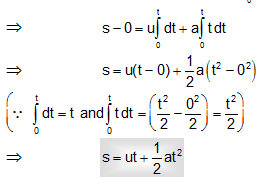Given a particle moving along a straight line with fixed acceleration a. Let u be the initial velocity of the particle and v be the velocity at time t. So by definition,
 dv = a dt
dv = a dt
Integrating, 
(a being a constant may be taken out of the integral) v - u = at
v = u + at ...(i)
Further,  dx = vdt
dx = vdt
But, v = u + at, dx = (u + at)dt
Integrating within limits, equations change into, 

...(ii)
Again, going back to definition of acceleration, we have, 
Multiply and divide RHS of above equation by dx, equation gets, 
 adv = adx
adv = adx
Integrating within limits, equation converts,  →
→ 
 →
→ 
...(iii)
From (i) and (iii) we also result that,  ...(iv)
...(iv)
Equation (iv) is a special equation, as we do not have a in this equation, but still it belongs to motion, which is uniformly accelerated.
To result, we again write the equation of motion for constant acceleration below.
v = u + at ; s = ut +  ;
; 
